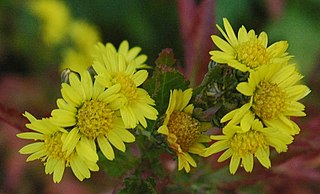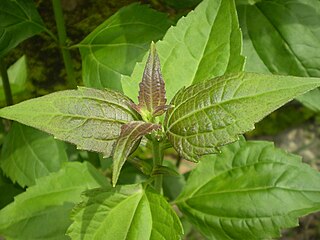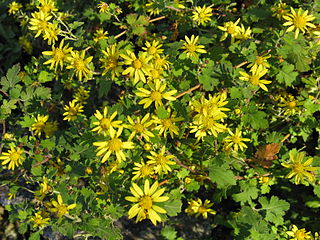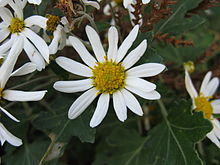
The family Asteraceae, with the original name Compositae, consists of over 32,000 known species of flowering plants in over 1,900 genera within the order Asterales. Commonly referred to as the aster, daisy, composite, or sunflower family, Compositae were first described in the year 1740. The number of species in Asteraceae is rivaled only by the Orchidaceae, and which is the larger family is unclear as the quantity of extant species in each family is unknown.

Cornus florida, the flowering dogwood, is a species of flowering tree in the family Cornaceae native to eastern North America and northern Mexico. An endemic population once spanned from southernmost coastal Maine south to northern Florida and west to the Mississippi River. The tree is commonly planted as an ornamental in residential and public areas because of its showy bracts and interesting bark structure.
Pyrethrum was a genus of several Old World plants now classified as Chrysanthemum or Tanacetum which are cultivated as ornamentals for their showy flower heads. Pyrethrum continues to be used as a common name for plants formerly included in the genus Pyrethrum. Pyrethrum is also the name of a natural insecticide made from the dried flower heads of Chrysanthemum cinerariifolium and Chrysanthemum coccineum. The insecticidal compounds present in these species are pyrethrins.

Chrysanthemums, sometimes called mums or chrysanths, are flowering plants of the genus Chrysanthemum in the family Asteraceae. They are native to East Asia and northeastern Europe. Most species originate from East Asia and the center of diversity is in China. Countless horticultural varieties and cultivars exist.

Leucanthemum vulgare, commonly known as the ox-eye daisy, oxeye daisy, dog daisy, marguerite and other common names, is a widespread flowering plant native to Europe and the temperate regions of Asia, and an introduced plant to North America, Australia and New Zealand.

Glebionis segetum is a species of flowering plant in the family Asteraceae, probably native only to the eastern Mediterranean region but now naturalized in western and northern Europe as well as China and parts of North America. Common names include corn marigold and corn daisy.

Safflower is a highly branched, herbaceous, thistle-like annual plant in the family Asteraceae. It is commercially cultivated for vegetable oil extracted from the seeds and was used by the early Spanish colonies along the Rio Grande as a substitute for saffron. Plants are 30 to 150 cm tall with globular flower heads having yellow, orange, or red flowers. Each branch will usually have from one to five flower heads containing 15 to 20 seeds per head. Safflower is native to arid environments having seasonal rain. It grows a deep taproot which enables it to thrive in such environments.

Floriculture is the study of the efficient production of the plants that produce showy, colorful flowers and foliage for human enjoyment and the human environment. It is a commercially successful branch of horticulture and agriculture found throughout the world. Efficient production practices have been developed over the years, for the hundreds of plant taxa used in the floral industry, increasing the overall knowledge of whole plant biology. Plant breeding and selection have produced tens of thousands of new genotypes for human use.

Cassia fistula, also known as golden shower, purging cassia, Indian laburnum, Kani Konna, or pudding-pipe tree, is a flowering plant in the family Fabaceae. The species is native to the Indian subcontinent and adjacent regions of Southeast Asia. It is the official state flower of Kerala state in India. It is also a popular ornamental plant and is also used in herbal medicine.

Tanacetum parthenium, known as feverfew, is a flowering plant in the daisy family, Asteraceae. It may be grown as an ornament, and may be identified by its synonyms, Chrysanthemum parthenium and Pyrethrum parthenium.

Gaillardia pulchella is a North American species of short-lived perennial or annual flowering plants in the sunflower family.

Glebionis coronaria, formerly called Chrysanthemum coronarium, is a species of flowering plant in the daisy family. It is native to the Mediterranean region. It is cultivated and naturalized in East Asia and in scattered locations in North America.

Chromolaena odorata is a tropical and subtropical species of flowering shrub in the family Asteraceae. It is native to the Americas, from Florida and Texas in the United States south through Mexico and the Caribbean to South America. It has been introduced to tropical Asia, West Africa, and parts of Australia.

Chrysanthemumbonsai is a Japanese art form using cultivation techniques to produce, in containers, chrysanthemum flowers that mimic the shape and scale of full size trees, called bonsai.

Chrysanthemum indicum is a flowering plant commonly called Indian chrysanthemum, within the family Asteraceae and genus Chrysanthemum.

Puccinia horiana is a species of fungus that causes chrysanthemum white rust, is a disease of plant species of the genus Chrysanthemum.

Chrysocephalum semipapposum, commonly known as clustered everlasting is a perennial shrub native to Australia. Clustered everlasting belongs to the family Asteraceae. C. semipapposum produces terminal flowers heads in clusters, mainly between spring and early summer with silver-grey appearing stems and branches. It grows up to 40cm high and 60 cm high, although there have been some varieties which can grow up to 1 m. C. semipapposum is often confused with Chrysocephalum apiculatum or 'yellow buttons', due to their similar appearances. C. semipapposum has 4 different subspecies, however they lack distinctive qualities and are often hard to identify. C. semipapposum is endemic to Australia and can be found in multiple states, most notably within Victoria. The plant is found in a variety of habitats including dry rocky regions. Clustered everlasting often grows sparsely and is rarely found in abundance and can be mistaken for a weed. Clustered everlasting has many uses, including as a source of nectar for butterflies, cut flowers or as an addition to a garden.

Chrysanthemum lavandulifolium is a flowering plant within the family Asteraceae and the genus Chrysanthemum. It is a perennial flowering plant that is often noted because of its yellow flowers. It has 18 chromosomes at the diploid stage.

Chrysanthemum × morifolium is a hybrid species of perennial plant from family Asteraceae.

Iris rossii, the long-tail iris, is a beardless iris in the genus Iris, in the subgenus Limniris and in the series Chinenses of the genus. It is a rhizomatous herbaceous perennial from Japan, Korea and China. It has narrow, grass-like leaves, short stems and 1 or 2 purple-violet flowers.



















